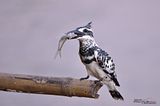I spent most of the time birding around the paddyfields in my local patch during the vacation. Now I'm back in Beppu, so I have to clear up those photos I took. Even though it had been raining a lot in Thailand, I actually liked it because it made the air much fresher and cooler, just perfect for a morning bicycle ride. I expected to see some interesting migrants but it seemed a bit too early for them. If I stayed in Thailand until the end of this month, there might be more chances for me to see some decent migrants. The most interesting one I saw was a single adult Chestnut-winged Cuckoo (Clamator coromandus) briefly landed just a few metres away from me and flushed out on the very same second it landed on the perch. It's a shame I couldn't get any photo of it since it's a very beautiful cuckoo as you can see here.
The same male Yellow-bellied Prinia (Prinia flaviventris delacouri) was still doing well protecting its own territory. I went back again with a tripod to get some more videos of the bird and the result is as above. Please try selecting the HD 1080p to fully enjoy the pleasure of viewing. There was also another juvenile bird hopping around in the same bush. I assumed it was the fledgling of this handsome male bird.



Juvenile and adult Chestnut-capped Babblers (Timalia pileata smithi)
Birds in my local patch were quite stable. All the familiar faces were still presenting well, especially the hyper-active Chestnut-capped Babbler (Timalia pileata smithi) family. The juveniles still seemed to hang out well with their parents even though they should be ready to live by themselves. A few Lesser Whistling-Ducks (Dendrocygna javanica) were staying in a small flooded area among the giant mimoca bush. I tried to get some good photos of them but they always swam into the bush right before I could get any decent shot. The above photo was my best try. A family of 2 adult and 2 small White-breasted Waterhen (Amaurornis phoenicurus) chicks and a juvenile Cinnamon Bittern (Ixobrychus cinnamomeus) were also staying in the same area.



Juvenile Cinnamon Bittern (Ixobrychus cinnamomeus)





Adult and juvenile Scaly-breasted Munias (Lonchura punctulata topela)
On the same day that I photographed the Black Baza at Mae Hia in the post below, I also got a chance to see a pair of Small Asian Mongooses (Herpestes javanicus) out in the open. It is very difficult to see this shy mammal in the open especially for a long period of time. I normally see them running away into the bush or swimming away, as they're also a good swimmer. The pair that I saw seemed to be interested in something in the paddyfield below. There were 2 White-breasted Waterhens, a Red-wattled Lapwing and 2 Chinese Pond-Herons trying to mob the mongooses, so I guess they were interested in something belonging to one of these birds. One of the mongooses was smaller with much darker fur and another one was larger with more brightly rufous fur. I realised that the smaller one was a female as they even performed a mating scene several times before disappearing into the grass.

























1 comment:
Wow! So many beautiful greens in this post and really love the first photo; the bird is posing so perfectly and the green arch framing him is just out of focus enough. Art.
Post a Comment